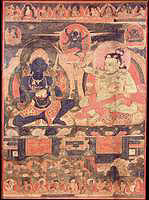
|
Mahasiddha Virupa (painting no. 1)
|

View Larger Image |
||||||||||||||
|
Virupa and Nairatmya, the dakini from whom he received the pith instructions of the Hevajra tantra. M. Mokotoff 11/97 * Sakya-pa tangka. The Lamdre lineage. To the left: Dagmema (Vajranairatma) To the right: Thubchen Birwapa (Mahasiddha Virupa) Virupa received teachings directly from Dagmema, while he was abbot of Nalanda University. At the top and bottom: 19 Indian Mahasiddhas of the Lamdre lineage Above Virupa: two aspects of Dagmema To left: Indian Mahasiddhas Virupa’s right hand stays up to hold the sun in place, a reference to the time when he was supposed to have been drinking 100 gallons of wine a day. The wine merchant required to be paid before the end of the day, so Virupa held the sun in the sky for 7 days. Lama Kunga Rinpoche 12/98 VAJRA NAIRATMYA (Tibetan: dor je dag me ma, English: Selfless One) and Shri Virupa (Bad One) along with the 'Extensive Lineage' of Indian gurus of the Hevajra Tantra. The central figure at the left is Vajra Nairatmya (consort of Shri Hevajra), female, dark blue in colour with one face and two hands holding a curved knife and skullcup at the heart with a katvanga staff resting against the left shoulder. Adorned with a tiara of skulls, bone ornaments and a skirt of tiger skin, she is in a semi-wrathful appearance, seated on a sun disc, multi-coloured lotus and throne. Shri Virupa, seated to the right, dark brown, performs a wrathful gesture with the right hand and holds a skullcup with the left. Adorned with flowers, a meditation belt and the Hevajra Tantra tied in the top-knot of hair on the crown of the head, he has the appearance of an Indian mahasiddha, seated on a leopard skin atop a lotus and throne. From the Buddhist historical point of view, the Tantric deity Nairatmya directly appeared to Virupa and bestowed the Hevajra empowerment - this is called the 'Near Lineage.' According to the Sakya Tradition, Virupa later appeared to Sachen Kunga Nyingpo in Tibet and again bestowed empowerments for Hevajra and consort and this is called the 'Very Near Lineage.' Directly above the heads of the two central subjects are three smaller figures. At the far left is a seated mahasiddha and in the center a dancing Vajra Nairatmya, blue, with one face and four hands. Another Vajra Nairatmya is seated at the right, blue, with two hands. Starting at the top left are the Indian lineage teachers of the Hevajra Tantra. Virupa is again included, placed third from the right next to one of his main students, Dombi Heruka, riding a tiger. Along the bottom are mahasiddhas not directly related to the main Hevajra lineage. Virupa is included in the set of 84 famous mahasiddhas and all, along with many more not included, have characteristic iconographic forms which can include colour, posture (asana), hand gestures (mudras), objects, and so on. With the less popular figures the characteristics are more static with less artistic or doctrinal variation. For example, Virupa, a popular figure has six general forms with different postures and hand gestures, and can appear in three variations of colour depending on the six forms. The form of Virupa with the right hand raised in a wrathful gesture is called 'the posture holding the sun.' Even though the generic iconographic characteristics are essential to know, by themselves they are not always reliable, a multiplicity of indicators must be looked for in determining a correct identification. Jeff Watt 5-1998
|
|||||||||||||||
Photographed Image Copyright © 1998 Shelley & Donald Rubin Foundation
| | |
Next Image |